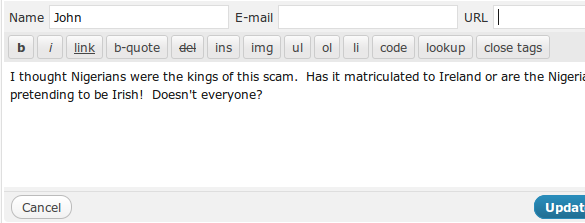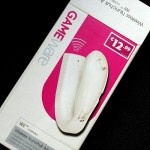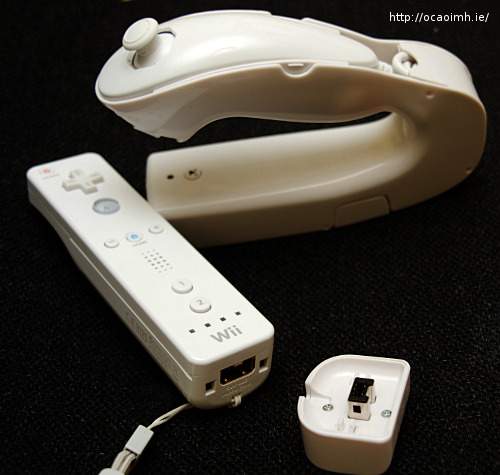With apologies to anyone named John. Spammers are getting more clever at spreading their links. Now legitimate website owners are using software tools that allow them to enter keywords of their choice to a create a list of related blogs with comment forms. Many of these applications list blogs that pass Google Rank to the websites of visitors. That’s why I stopped doing the “dofollow” thing several months ago. Since then the number of spam comments has gone down slightly. Cookie for Comments stops the spam bots dead but the human spammer scum still get through.
Next time Akismet marks a legitimate looking comment as spam (or you get a comment from someone who was supposedly christened Austin Texas Photographer by his parents), check your logs. Look up the IP address of the visitor. You may find something like this. Note the lack of a referrer, an old Firefox user agent and then “bsalsa.com” is in the UA of the next request for a post. Bsalsa make a Windows toolkit that this software obviously uses. They’re fans of Borland Delphi apparently!
"GET /2006/11/04/cork-cinema-listings/ HTTP/1.0" 200 43366 "-" "Mozilla/5.0 (Windows; U; Windows NT 5.1; en; rv:1.8.1.11) Gecko/20071127 Firefox/2.0.0.12"
"GET /feed/ HTTP/1.0" 302 84 "-" "Mozilla/5.0 (Windows; U; Windows NT 5.1; en; rv:1.8.1.11) Gecko/20071127 Firefox/2.0.0.11"
"GET /2006/11/04/cork-cinema-listings/ HTTP/1.1" 200 12089 "-" "Mozilla/4.0 (compatible; MSIE 7.0; Windows NT 5.1; GTB6; User-agent: Mozilla/4.0 (compatible; MSIE 6.0; Windows NT 5.1; SV1; http://bsalsa.com) ; User-agent: Mozilla/4.0 (compatible; MSIE 6.0; Windows NT 5.1; SV1; http://bsalsa.com) (Mozilla/5.0 (Windows; U; Windows NT 5.1; en; rv:1.8.1.11) Gecko/20071127 Firefox/2.0.0.11); .NET CLR 2.0.50727)"
When my blogs were dofollowing, I’d get loads of spam comments every day. The tools used fire off a request to the blog to examine the links on that page. They highlight dofollow links so the user knows their spam comment will generate Google Juice for their site.
I was getting so sick and tired of them I contacted several spammers. Lindsay who commented on inphotos.org replied:
Hi Lindsay,
As a photographer, I’m always looking for other blogs to comment on but it’s hard to find interesting photoblogs that post anything other than photos. How did you find my blog? I didn’t see a Google search in my logs. Is it a special program?
Thanks,
Donncha
She was really helpful, even replying twice when I didn’t reply again:
I actually have a program called G-force fast blog finder. Basically, i put in some keywords and it searches ALL blogs with those keywords. THEN it tells me if those blogs do or do not have the “uComment iFollow” addon. Blogs that allow the “follow” tag are good for search engines if i post a comment with a link to my site.. SO basically, i get to look at photography blogs and comment on them while i help my website obtain some more links.
Basically, search engines rank your page based on a few things, one of them is link backs. Basically, a link from a site to my site is like a vote for my site saying it is good. So the more other websites link to my site, the better.. HOWEVER, some blogs and websites have the NOFOLLOW tag in them which does not let the search engines see it. Your site does allow the uComment iFollow.
We also created a link exchange program on our website. if you’re interested, it helps you too also have links for your site on other people’s site. If you go to my site here:
http://__________.com/catalog/links.php
You can submit your link and even a small picture to be displayed.
Let me know if you have any other questionsLindsay
Yea. I Down loaded a program called fast blogger. They have a free trial and basically you add in search term and it searches all blogs for that term. It gives you lists of links to them and tells you if they are no follow or Ufollow IConment blogs. Basically, by findig blogs related to my webstie and blog and posting comments, it helps my website with the search engines when I post a link. It’s a win win situation. You get blog views and comments and the post gets a link back to third site.
If you are interested, I also have a blog. It’s at http://_____________.com/blog
Feel free to comment away and leave a link back to your blog.
We also have a link exchange. Basically you go to Http://____________.com/catalog/links.php
Click submit link and then we will add another link to our website. All we ask is you link back to us in return.
It’s basically everyone helping each other in order to get good page ranking for thief keywords
If you have any questions , Id be happy to answer.
Lindsay
Very helpful wasn’t she? Unfortunately it was the final straw. All links in comments are nofollowed again. Bloody spammers.
The spam comments continue but recently I’ve taken to changing the name of the person to “John”, removing their email and url and then allowing through the comment.


Thanks John!



 This isn’t the first time a Commodore 64 laptop has been made but it’s probably the coolest one. Commodore’s original
This isn’t the first time a Commodore 64 laptop has been made but it’s probably the coolest one. Commodore’s original  A couple of years ago there was the
A couple of years ago there was the 